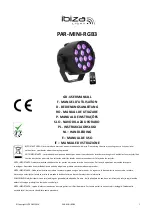
Millikan Oil Drop Apparatus
AP-8210A
®
1
-Introduction
The PASCO Millikan Oil Drop Apparatus is designed to conduct the Millikan Oil Drop Experiment where the
electric charge carried by a particle may be calculated by measuring the force experienced by the particle in an
electric field of known strength. Although it is relatively easy to produce a known electric field, the force exerted
by such a field on a particle carrying only one or several excess electrons is very small. For example, a field of
1000 volts per centimeter would exert a force of only 1.6 10
-9
dyne (1 dyne = 10
-5
newtons) on a particle bearing
one excess electron. This is a force comparable to the gravitational force on a particle with a mass of 10
-l2
(one
million millionth) gram.
The success of the Millikan Oil Drop experiment depends on the ability to measure forces this small. The behavior
of small charged droplets of oil, having masses of only 10
-12
gram or less, is observed in a gravitational and an
electric field. Measuring the velocity of fall of the drop in air enables, with the use of Stokes’ Law, the calculation
of the mass of the drop. The observation of the velocity of the drop rising in an electric field then permits a calcu-
lation of the force on, and hence, the charge carried by the oil drop.
Although this experiment will allow one to measure the total charge on a drop, it is only through an analysis of the
data obtained and a certain degree of experimental skill that the charge of a single electron can be determined. By
selecting droplets which rise and fall slowly, one can be certain that the drop has a small number of excess elec-
trons. A number of such drops should be observed and their respective charges calculated. If the charges on these
drops are integral multiples of a certain smallest charge, then this is a good indication of the atomic nature of elec-
tricity. However, since a different droplet has been used for measuring each charge, there remains the question as
to the effect of the drop itself on the charge. This uncertainty can be eliminated by changing the charge on a single
drop while the drop is under observation. An ionization source placed near the drop will accomplish this. In fact, it
is possible to change the charge on the same drop several times. If the results of measurements on the same drop
then yield charges which are integral multiples of some smallest charge, then this is proof of the atomic nature of
electricity.
The measurement of the charge of the electron also permits the calculation of Avogadro’s number. The amount of
current required to electrodeposit one gram equivalent of an element on an electrode (the faraday) is equal to the
charge of the electron multiplied by the number of molecules in a mole. Through electrolysis experiments, the far-
aday has been found to be 2.895 x 10
14
electrostatic units (e.s.u.) per gram equivalent weight (more commonly
expressed in the m-k-s system as 9.625 x 10
7
coulombs per kilogram equivalent weight). Dividing the faraday by
the charge of the electron,
yields 6.025 x 10
23
molecules per gram equivalent weight, or Avogadro’s Number.
Equation for Calculating the Charge on a Drop
An analysis of the forces acting on an oil droplet will yield the equation for the determination
of the charge carried by the droplet. Figure 1 shows the forces acting on the drop when it is
falling in air and has reached its terminal velocity. (Terminal velocity is reached in a few mil-
liseconds for the droplets used in this experiment.) In Figure 1,
v
f
is the velocity of fall,
k
is the
coefficient of friction between the air and the drop,
m
is the mass of the drop, and
g
is the
acceleration of gravity. Since the forces are equal and opposite:
2.895
x
10
14
e.s.u./gm equivalent weight
4.803
x
10
10
–
e.s.u.
----------------------------------------------------------------------------------------------
kv
f
mg
Figure 1
mg
kv
f
( 1 )
=






































